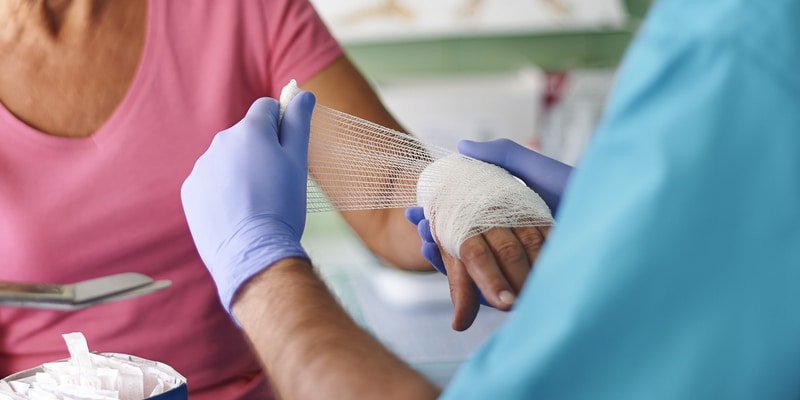
This article was published on: 09/14/23 4:49 AM
What are Orthopaedic Injuries?
Orthopaedic Injuries are injuries that are caused by some external force to your bones, joints or soft tissues which require immediate attention and treatment. They include any injury to the musculoskeletal system. It is usually seen in athletes, one with weak bones or had met with some accident, etc. Orthopaedic Injuries differ from minor fractures to life-threatening accidents. It can be caused by falling, road accidents, physical violence, sports, natural calamities, etc. Bones tend to become weak with age and therefore older people are more prone to orthopaedic injuries.
What are the Common Orthopaedic Injuries?
Some of the common orthopaedic injuries are Dislocations, Fractures, Breaks, Impingement, Sports Hernia, Overuse Injuries, Sprains, etc while some acute orthopaedic injuries include sprained ankle, ACL Tear, Meniscus Tear, Plantar Fasciitis, Labral Tear, Rotator Cuff Tear, Tennis Elbow, Carpal Tunnel Syndrome, Wrist Fracture, Stress Fracture, etc.
Dislocations:
A dislocation is a separation of two bones at a joint where they meet. They are the ones that are pushed away from their actual place. Dislocations can be very painful and can restrict your movement. The most common parts that are dislocated are fingers, shoulders, knees, elbows, hips, etc.
Types of dislocations: There are two types of dislocations i.e luxation and subluxation. Luxation refers to complete dislocation wherein the bones are completely separated from the joints whereas subluxation refers to partial dislocation wherein the bones are still in touch with the joint but not as it is supposed to be.
Causes: Any strong force that can push your joints may lead to dislocation. Some of the causes of dislocation include car accidents, sports injuries, falls, etc.
Symptoms: Some of the symptoms of dislocations are pain, swelling, bruising, restricted movements, instability, weakness in the joints, etc.
Fractures:
A fracture is a break in the bone. It ranges from small partial cracks to complete broken bones and can occur in any bone of the body.
Types of fractures: There are different types of fractures such as stable fracture, open fracture, oblique fracture, transverse fracture and comminuted fracture. In a stable fracture, the bones are barely out of place. Open fracture also known as compound fracture breaks the skin at the time of the fracture in which the bone may or may not be visible in the wound. Oblique fracture has an angled pattern. A transverse fracture has a horizontal fracture line and in a comminuted fracture, the bone breaks into three or more pieces.
Causes: Some of the common causes of fractures are trauma, osteoporosis and overuse which may lead to the stress fracture.
Symptoms: Symptoms of fractures include pain, bruising, swelling, restricted movements, discoloured skin around the affected area, bleeding in case of open fracture, grating sensation, etc. In severe cases, a person may even experience dizziness, faintness or nausea.
Impingement:
Impingement is a condition in which the tendons of the shoulder are pinched. It generally occurs when the humerus (outer edge of the shoulder blade) is pinched or rubbed against the acromion (tip of the shoulder).
Types: There are four types of shoulder impingement. They are Anterior subacromial impingement, Posterosuperior glenoid rim, Subcoracoid Impingement, and Suprascapular nerve impingement.
Causes: Some of the causes of impingement include torn or swollen tendons, irritated or inflamed bursa, bone spurs, etc.
Symptoms: Symptoms of impingement are pain while you move your shoulder, shoulder weakness, stiffness, swelling, tenderness, etc.
Sports Hernia:
Sports Hernia is a painful injury that occurs in the lower abdomen or groin. It is an injury to the muscles or tendons that causes chronic pain. It usually happens while playing sports when you extend your body part beyond its capacity or while intense twisting.
Causes: Sports that involve repetitive and forceful moments such as soccer, football, tennis, wrestling, etc can cause damage or tear to the soft tissue. Some of the other causes include vigorous abdominal and hip exercises, weakness in the abdominal muscles, repetitive hip movements, etc.
Symptoms: Some of the symptoms of sports hernia include sudden pain at the time of injury, pain reaching the inner thigh, pain in the groin while coughing and sneezing, restricted movements, swelling, etc.
Overuse Injuries:
Overuse Injuries refer to repetition that leads to inflammation or tearing of tissue. This may result in a stress fracture, ligament strains, etc.
Causes: Overuse Injury is usually caused due to repetitive activities over a while. Some of the other causes include training errors or technical errors.
Symptoms: Symptoms of overuse injuries are pain, numbness and tingling in the affected area, soreness, stiffness, popping sensation, etc.
Sprains:
A sprain refers to the stretching, pulling or tearing of the ligaments around the joints. Ligaments are strong and flexible fibres that help in holding the bones together.
Types: There are different types of sprains such as ankle sprain, knee sprain and wrist sprain.
Causes: Sprain can be caused by either direct or indirect injury such as rolling your ankle, falling or slipping on a wet surface, walking or exercising on an uneven surface, improper landing, etc.
Symptoms: Some of the Symptoms of a sprain include pain, swelling, bruising, restricted movement, popping sensation, etc.